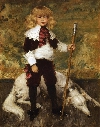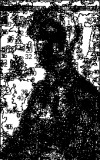American Impressionist painter William Merritt Chase was born on November 1, 1849, in Williamsburg, Indiana.
His parents had six other children after his birth. William’s father, a businessman, decided to re-locate his family to Indianapolis in 1861, when Chase was twelve. In Indianapolis, the young man was hired by his father to be a salesman.
 Chase’s artistic talent was not necessarily nurtured in his childhood. He received early training from Jacob Cox and Baton S. Hays, artists who were self-taught. Though Chase had very humble beginnings, studying under non-notable teachers, he would mature to become a famous impressionist painter.
Chase’s artistic talent was not necessarily nurtured in his childhood. He received early training from Jacob Cox and Baton S. Hays, artists who were self-taught. Though Chase had very humble beginnings, studying under non-notable teachers, he would mature to become a famous impressionist painter.
William Merritt Chase joined the army only to be encouraged by his teachers to seek further artistic training. He received this advice, and in 1869 moved to New York to study with Joseph Oriel Eaton. Soon after, he began studying at the National Academy of Design. Lemuel Wilmarth, pupil of Jean-Léon Gérôme, taught Chase during his time at the National Academy.
Although he grew rapidly under the tutelage of excellent art instructors at the National Academy of Design, Chase moved to St. Louis in 1870 to help support his financially struggling family. He did this by selling still life paintings. While in St. Louis, he was involved in the local art community. He won prizes and awards for the excellence of his works. The time spent in St. Louis was something of a springboard for Chase’s career, as it gave him an opportunity to exhibit his works and showcase his rare talent.
Chase’s artistic talent was evident to all, including the elite and upper class of St. Louis. These wealthy individuals favored Chase and provided a way for him to live in Europe for two years. Their only stipulation was that he would provide them with paintings and assist them in obtaining the European art they desired for their collections.
 The burgeoning artist’s two years in Europe were excellent for his stylistic development. He enrolled at the Academy of Fine Arts in Munich and was privileged to be a student of Karl von Piloty and Alexander von Wagner. During his time in Munich, Chase sought out friendships with other American artists, including Joseph Frank Currier, Frank Duveneck, and Walter Shirlaw.
The burgeoning artist’s two years in Europe were excellent for his stylistic development. He enrolled at the Academy of Fine Arts in Munich and was privileged to be a student of Karl von Piloty and Alexander von Wagner. During his time in Munich, Chase sought out friendships with other American artists, including Joseph Frank Currier, Frank Duveneck, and Walter Shirlaw.
While in Munich, William Merritt Chase began to experiment with his artistic style. He painted figurative works in the “loosely-brushed style popular with his instructors.” His painting titled “Keying Up” is an example of his work from this time period (1876). Chase was later awarded a medal for “Keying Up” by the Philadelphia Centennial Exhibition.
In 1878 Chase moved to New York and began teaching art. A few years later, in 1886, he married Alice Gerson, whom he had eight children with. Alice, along with two of Chase’s daughters, frequently posed for him.
William Merritt Chase established and instructed at the Shennecock Hills Summer School in 1890. It was at this school, located in New York, that he taught the “plein air method of painting” (meaning he taught his students out of doors). The Chase School of Art was opened in 1896.
His ability to excellently paint many different subjects was one of the defining talents of Chase, the artist. Throughout his life he regularly painted portraits, landscapes, studio interiors, figures, cityscapes, and still life pictures.
On October 25, 1915, the world lost a painter who had contributed much to society. William Merritt Chase passed away in his Town House in New York. He died a well-respected, highly esteemed artist and teacher.
Chase’s New York studio and home (now known as the William Merritt Chase Homestead) are both part of the National Register of Historic Places. Chase is an example of an artist who worked with integrity and relentlessly developed his talent. He is still celebrated to this day.
William Merritt Chase established a school for artists known as the Chase School. He played various roles in his life including an artist, teacher, father, and sophisticated cosmopolitan. Although he worked with all media, he was most talented in oil painting and pastel, as well as watercolor.
He is best known for his portraits, who sitters included important people of the day and also his family members. Locations including Prospect Park, Central Park in New York City, and Shinnecock Hills on Long Island were popular locations for his outdoor paintings.
Patterns includes several self portraits, and numerous portraits including Portrait of a Lady, lady in Pink, Lady in Black, The Blue Kimono, Girl in Red Embroided Jacket, The Mandolin Player, Still Life Fish, At the Seaside, Azaleas, Girl in Japanese Costume, Portrait of Miss Dora Wheeler, and Portrait of Louis Betts.
Do you have a favorite Impressionist Painter? If you could paint an impressionist painting, what color would you choose? Share with Segmation by leaving a comment below.
Sources:
http://en.wikipedia.org/wiki/William_Merritt_Chase
Coming soon: If you love art as well as technology, you won’t want to miss our upcoming blog post about word cloud portraits.
Did you like this Segmation blog post? If yes, you’ll enjoy:
— Paul Cézanne – Post Impressionist
https://www.segmation.com/2013/03/25/paul-cezanne-post-impressionist/
— First Female Tattoo Artist Starts a Cultural Phenomenon
https://www.segmation.com/2013/03/22/first-female-tattoo-artist-starts-a-cultural-phenomenon/
— How to Create Bean Art: a Tutorial
https://www.segmation.com/2013/03/04/how-to-create-bean-art-tutorial/
Be an Artist in 2 minutes with Segmation SegPlay® PC (see more details here)
Join us on Facebook SegPlay® Mobile iTunes now available for iPhone and iPad










Whenever I think of Impression my thoughts go to Monet and friends. Your post reminded me that Impressionism cannot be confined to borders. A great post about an American Impressionist painter!!
I was surprised to find that there was an American Impressionist painter! Glad you like my post!
I always do… 🙂
Never heard of him until your post – thanks and will check him out today